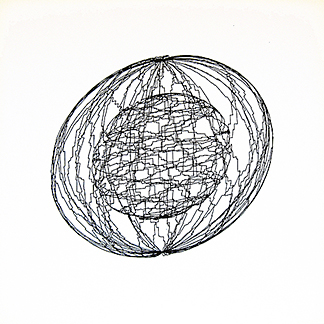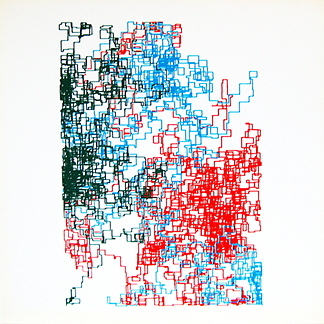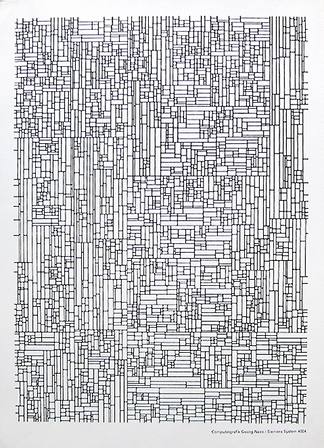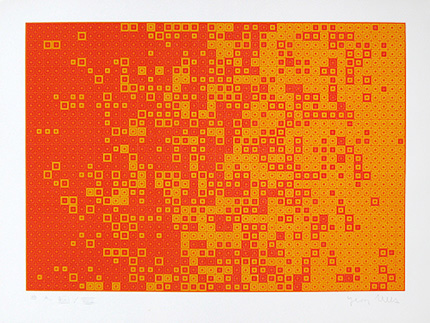Pioneer Work: Georg Nees
The mathematician Georg Nees (1926-2016) was the first artist to present computer graphics as art in an exhibition initiated by Max Bense in
February 1965 (read more).
»Pioneer Work: Georg Nees« presents some of his works generated between 1965 and 1970.
Pioneer Work #1 Sculpture 1
The motif of this print is Georg Nees three-dimensional wooden sculpture »Sculpture 1«, which had been created with a (via punch card) program controlled milling machine.

|

|
Georg Nees:
Sculpture 1
offset lithography after photograph of wood sculpture, 1970
Idea and program by Georg Nees
Sculpture generated between 1965 and 1968 with a Siemens-system 2002 and 4004,
programmed in EXAP-1 for a Sinumerik milling machine
Publicized in Georg Nees: Generative Computergraphik, 1969
|

Pioneer Work #2 Sculpture 2
This print shows »Sculpture 2«. Like the sculpture above, it is based on a program written in EXAP-1,
which was transferred to a punch tape for the milling machine.

|

|
Georg Nees:
Sculpture 2
offset lithography after color photograph of sculpture, 1970
Idea and program by Georg Nees
Sculpture generated: around 1968 with a Siemens system 4004,
programmed in EXAP-1 for a Sinumerik milling machine
Publicized in Georg Nees: Generative Computergraphik, 1969.
|

Pioneer Work #3 Untitled
This print s motif is an untitled multi colored computer graphic.

|

|
Georg Nees:
untitled
offset lithography after plotter drawing, 1970
Idea and program by Georg Nees
Generated: around 1970, probably with a Siemens system 4004,
Publicized in Ex Machina catalogue (No. 351)
|

Pioneer Work #4 Hall (Corridor)
The computer graphic Hall (Corridor) depicts textures and figures in a perspective view.
At the end of the 1960s this graphic showed the potential of the computer for architectural design and depiction.

|

|
Georg Nees: Hall (Corridor)
offset lithography after plotter drawing, 1970
Idea and program by Georg Nees
Generated: between 1965 and 1968 with Siemens 2002
Programmed in ALGOL and drawn on a ZUSE-Graphomat Z64 plotter
Publicized in Georg Nees: Generative Computergraphik, 1969.
|

Pioneer Work #5 Sphere in a Sphere
The sphere motif is also a perspectively designed computer graphic. This computer graphic was also part of the 1969 Hanover exhibition »Computer-Kunst - On the Eve of Tomorrow«.
Nees presented a simpler variation in his book »Generative Computergraphik«.

|

|
Georg Nees:
Sphere in a Sphere
offset lithography after plotter drawing, 1970
Idea and program by Georg Nees
Generated: around 1969, with a Siemens 2002 (acc. Nees),
Programmed in ALGOL and drawn on a ZUSE-Graphomat plotter
Publicized in Ex Machina catalogue (349, in color)
|

Pioneer Work #6 Untitled (Butterfly Swarm)
The graphics of the series »Butterfly Swarm« were generated by the use of a random generator.
Nees wrote about the different figures of the »butterflies« in the swarm forming a »graphical alphabet«,
the »alphabet of butterfly figures« which is defined by program parameters.

|

|
Georg Nees:
Untitled (Butterfly Swarm)
offset lithography after plotter drawing, 1970
Idea and program by Georg Nees
Generated: around 1969, probably with a Siemens system 4004,
Similar motifs from the swarm-series publicized in Georg Nees: Generative Computergraphik, 1969
|

Pioneer Work #7 Untitled
The motif of this computer graphic is a texture of overlapping forms, generated by the use of a random generator.
To produce a texture, Nees imitates a corrosion process in the generative graphic by using random numbers.

|

|
Georg Nees:
untitled
offset lithography after plotter drawing, 1970
Idea and program by Georg Nees
Generated: around 1970, probably with a Siemens system 4004,
Publiziert im Ex Machina Katalog (Nr. 351, Inv. Nr. 2006/41e) / Publicized in Ex Machina catalogue (No. 351, Inv. Nr. 2006/41e)
|

Pioneer Work #8 Untitled
This motif is an ornament developed by Nees which was later used to demonstrate the use of the computer in textile design and industry.

|

|
Georg Nees:
untitled
offset lithography after plotter drawing, 1970
Idea and program by Georg Nees
Generated: around 1970, probably with a Siemens system 4004,
A similar motif from this series was publicized in the Ex Machina catalogue.
|

Pioneer Work #9 Untitled (Surface Ornament)
This computer generated graphic depicts a surface ornament.
The ornament is created by periodically initiated random generators, which results in a checkered ornament structure.

|

|
Georg Nees: untitled (Surface Ornament)
offset lithography after plotter drawing, 1970
Idea and program by Georg Nees
Generated: around 1970, probably with a Siemens system 4004
A similar motif from the series of surface ornaments was publicized in Georg Nees: Generative Computergraphik, 1969.
|

Pioneer Work #10 Untitled (The Palace of Midas)
This motif, which has been printed in different variations, is also a texture. The irregular rectangular pattern looks like the floor texture of ancient buildings.

|

|
Georg Nees:
untitled (the motif is a rotated section of The Palace of Midas)
offset lithography after plotter drawing, 1970
Idea and program by Georg Nees
Generated: between 1965 and 1968, with a Siemens 2002
Programmed in ALGOL and drawn on a ZUSE-Graphomat plotter
Publicized in Ex Machina catalogue (extended motif, printed red on white paper)
|
Nees released a similar print with the same motif, titled The Palace of Midas:

|

|
Georg Nees:
untitled (The Palace of Midas)
screen print after plotter drawing, around 1970
Idea and program by Georg Nees
Generated: between 1965 and 1968, with a Siemens 2002 (Siemens 4004, acc. print)
Programmed in ALGOL and drawn on a ZUSE-Graphomat plotter
Publicized in Ex Machina catalogue (motif in red on white paper)
|

Pioneer Work #11 Kubo-Oktaeder
For more on this computer generated graphic, see webpage Kubo-Oktaeder.

|

|
Ludwig Rase, Georg Nees:
Kubo-Oktaeder
screen print for the exhibition »computer art« at Kunsthalle Hamburg 1972/73
screen print after plotter drawing, 1972
Idea: Georg Nees, Ludwig Rase
Program: Georg Nees
Generated 1968-1970 (acc. catalogue »Ex Machina«), likely in Munich, Germany.
Programmed in ALGOL for
Siemens 4004 (acc. to print) and
drawn on a ZUSE-Graphomat Z64.
|

Pioneer Work #12 Signal Ellipse
The motif of this drawing is the closing illustration in Nees book »Generative Computergraphik«.
He describes it as a case study demonstrating the organization of an information field by a recipient into a passive background and an active foreground.

|

|
Georg Nees: Signal Ellipse
ZUSE Graphomat Z 90 Drawing, around 1970
Idea and program by Georg Nees
Generated: 1969
Programmed in ALGOL for
Siemens System 2002
Lit.:
Generative Computergraphik by Georg Nees, Illustration No. 52, page 288
Ex Machina Catalogue, Kunsthalle Bremen, page 439
|

Pioneer Work #13 Art ex machina

The Mainframes
Nees programmed his early graphics on Siemens systems, he also worked for Siemens as a computer scientist, e.g. on architectural projects.
Siemens System 2002 was sold between 1959 and 1966, but continued to be used for many more years.
The Siemens 4004 system originated from a Cooperation with Radio Corporation of America (RCA). RCA had developed mainframes,
which were sold in the series SIEMENS 4004 in Germany
(see Siemens History).

|

|
Sculpture 1 by Georg Nees on the cover of the Siemens magazine, December 1969.
|

Artist's Profile
Georg Nees (1926-2016)
Born 1926 in Nuremberg, Germany, studied mathematics, physics and philosophy in Erlangen and in Stuttgart, Germany.
As a student with Max Bense first exhibition of computer art in Germany.
Ph.D. in 1969 in »Generative Computergraphik«.
Watch on You Tube: Georg Nees at ZKM (in German) and an
interview with Nees and other pioneers.
On Wikipedia: Georg Nees
Many »pioneer works« shown above have been on display in major computer art exhibitions, e.g. in:
»computer art. nees rase.«, Hamburger Kunsthalle, Germany, 29.9.1972 - 14.1.1973
Georg Nees – The Great Temptation. Early generative computer graphics. ZKM Karlsruhe, Germany, 2006
»Ex Machina – Frühe Computergrafik bis 1979« Kunsthalle Bremen, Germany, 2007
»bit international. [Nove] tendencije. Computer und visuelle Forschung Zagreb 1961-1973« Neue Galerie Graz am Landesmuseum Joanneum, Austria, 2007
»bit international« ZKM Karlsruhe, Germany, 2008-2009
»Programmierte Kunst. Frühe Computergraphik.« Kunsthalle Bremen, Germany, 2018
»Chance and Control: Art in the Age of Computers« Victoria and Albert Museum, London, GB, 2018
and e.g. publicized in:
Generative Computergraphik. Georg Nees (1969)
Computer-Grafik Galerie. Herbert W. Franke (1984)
Ex Machina – Frühe Computergrafik bis 1979. Hrsg. Wulf Herzogenrath und Barbara Nierhoff-Wielk (2007)
A Little-Known Story about a Movement, a Magazine and the Computer's Arrival in Art: New Tendencies and Bit International. Hrsg. Margit Rosen (2011)
Computergraphik – Computerkunst. Herbert W. Franke (1985)
The information given on the prints above, like printing technique, year of creation etc., is to the best of my knowledge but without engagement.

|
|
















